In the context of increasingly fierce competition, cost optimization in business is one of the important factors that help businesses improve operational efficiency, maximize profits without affecting the quality of products or services. Effective cost management not only helps businesses save resources but also ensures sustainable development.
In this article, Bizzi will help you learn about the concept, goals and importance of cost optimization, and distinguish it from cost cutting.
1. General introduction
1.1 What is cost optimization in business?
Cost optimization in business is the process of analyzing, evaluating and adjusting expenses to ensure the business operates effectively at the most reasonable cost. This does not mean cutting costs to the extreme but focuses on using the budget wisely, minimizing waste and maximizing the value from each investment.

1.2 Objectives of cost optimization
Cost optimization is not only about minimizing expenses but also ensuring that businesses can:
- Increase profits: Reducing unnecessary costs means increasing net profits.
- Improve performance: Reasonable budget allocation helps increase productivity and operational efficiency.
- Ensuring sustainability: Helps businesses maintain financial stability and limit long-term risks.
- Improve competitiveness: Businesses can price products/services more reasonably, attract customers while still ensuring profits.
1.3 The importance of cost optimization
Cost optimization plays an important role in business growth, especially during economic turmoil. A sound cost strategy helps businesses:
- Maintain a steady cash flow: Reduce financial pressure, increase the ability to invest in new opportunities.
- Improve financial management efficiency: Helps accountants and management easily monitor and control spending.
- Reduce waste: Eliminate unnecessary expenses, focus on value-creating activities.
1.4 Distinguish between cost optimization and cost cutting
| Criteria | Cost optimization | Cut costs |
| Target | Manage costs effectively, maintain quality | Cut spending quickly, regardless of the consequences |
| Time | Long term, sustainable | Short term, temporary |
| Scope | Optimizing processes and technology | Cut down on staff and materials |
| Effective | Maintain growth and performance | Risk of quality loss, affecting operations |
2. Challenges in cost optimization
Managing and optimizing costs in a business is an important but not simple task. Below are common challenges that businesses often encounter in this process:
2.1 Lack of clear understanding of costs
One of the biggest obstacles is that businesses do not have detailed information about the origin and structure of costs. Without transparent data, it becomes difficult to analyze and make decisions about cutting or allocating budgets appropriately. Therefore, businesses need to invest in smart cost management tools to accurately track and evaluate each expenditure.
2.2 Difficulties in changing organizational culture
Cost optimization in a business is not just about tweaking the numbers, but also about changing the mindset and working habits of employees. To be effective, it requires strong commitment from the top management and buy-in from the entire organization. Without a coordinated approach, any cost-saving efforts can be thwarted.
2.3 Risk of price changes from suppliers
Prices for raw materials and services can fluctuate with the market, affecting a company’s cost strategy. Negotiating long-term contracts or finding alternative suppliers can help mitigate this risk.
2.4 Technology integration capabilities
Technology plays an important role in controlling and optimizing costs in businesses. However, many businesses are hesitant to invest in automation solutions due to high initial costs and long implementation times. To overcome this, businesses can apply technology solutions in stages, starting with tools that are cost-effective but highly effective.
2.5 Negotiating labor contracts
Adjusting working conditions or reducing working hours to cut costs can cause negative reactions from employees. This requires businesses to have a clear internal communication strategy that ensures the interests of both the organization and employees.
2.6 Challenges of international supply chains
For businesses with global operations, shipping, tax, and customs costs can fluctuate dramatically, directly impacting budgets. To manage risk, businesses need to develop contingency plans, closely monitor market trends, and optimize their supply chains by collaborating with strategic partners.

3. Some ways to optimize costs in business
In the context of economic fluctuations, cost optimization in enterprises has become a mandatory requirement to maintain profits and sustainable growth. Below are effective solutions to help enterprises manage their finances better.
- Human resource management:
- Evaluate employee performance.
- Optimize staffing (remote working, flexible contracts).
- Review and evaluate human resource needs and performance.
- Optimize human resource management structure and processes.
- Using modern technology:
- Software integration and automation systems.
- Reduce infrastructure costs and increase efficiency.
- Use management software (work management, human resources, projects, cost management such as Bizzi Expense).
- Optimize advertising and marketing:
- Evaluate your current strategy and focus on effective channels.
- Use free marketing channels (social media, blogs, email marketing).
- Create quality content and engage with customers.
- Improve labor productivity:
- Train employees to become experts.
- Improve workflow to reduce work time.
- Negotiation with suppliers:
- Guaranteed best prices and favorable terms.
- Establish stable partnerships.
- Regularly review contracts.
- Supply chain optimization:
- Reduce shipping, storage and inventory management costs.
- Efficient inventory management.
- Monitor the market and ensure a diverse, flexible supply chain.
- Developing customer relationships:
- Reduce acquisition costs and increase value from existing customers.
- Focus on customer service and quick response.
- Research and Development (R&D):
- Bring new products and services, reduce production costs.
- Use customer feedback to improve products.
- Financial organization and management:
- Manage finances carefully to reduce risk and optimize investment opportunities.
- Review and update budget plan.
- Building a sustainable cost strategy:
- Set and maintain a sustainable cost strategy.
- Define long-term cost and performance strategies.
- Optimizing input costs:
- Find new sources of supply at lower costs.
- Optimize inventory management process.
- Look for alternative sources of raw materials.
- Building cost norms:
- Determine cost norms for each activity.
- Monitor and control costs according to standards.
- Build a reward and incentive mechanism when reaching the target.
- Outsource short-term jobs:
- Flexible, productive and cost effective.
- Save costs related to office equipment and space.
- Automate and process repetitive tasks
- Improve coordination processes between departments:
- Streamline processes to avoid wasting human resources.
- Minimize conflicts and costs.
- Digitalize office, reduce physical documents and records:
- Save on printing and storage costs.
- Enhanced security and information accessibility.
- Optimize unnecessary expenses:
- Periodically review your expenses and eliminate those that don't add value.
- Monitor and evaluate the effectiveness of reduction measures.
- Optimize the cost of “Idle Resources”:
- Measure, control and allocate work appropriately.
- Automate your workflow.
- Building a quality management and control system:
- Monitor and evaluate the effectiveness of production and supply processes.
- Establish a system of periodic quality control and assessment.
- Continuously improve quality based on customer feedback.
- Limit investment spread:
- Focus on strengths and narrow investment scope.
- Become a subcontractor.
- Optimize business opportunities:
- Analyze market, potential partners to identify opportunities.
- Assess competitiveness and develop appropriate strategies.
- Develop new products and services that match business opportunities.
- Use effective time strategies
- Limit distractions that waste time, helping employees stay focused on their work
- Use management software to track employee time usage, time spent on different types of work activities or projects
- Applying information technology
- Online meetings will greatly reduce travel costs, “online meeting rooms” can eliminate the need for physical meeting space and rooms.
- Make the most of your workspace
- Analyze current workspace utilization.
- Merging different functional departments or divisions of the business
- Maximize employee skills
- Evaluate the utilization of employee experience and skills.
- Give responsibility to the employee who is most skilled and productive in that area.
- Arrange the right people for the right job
- An effective HR process will include recruiting and placing the right people in the right roles.
- Pay attention to the “hard to control” parts
- What many people don't look at are the departments that don't have KPIs/OKRs, like admin or back office in many businesses.
- Focus on quality
- Product quality will help sell the product, whether it is goods or services.
- Link and cooperate with other companies
- Link into a network, support each other to develop together.
- Always keep track of your budget
- Budget planning and management go hand in hand with cutting business costs.

4. How does Bizzi Expense help you optimize costs?
In a volatile business environment, cost control is a key factor in helping businesses maintain profits and grow sustainably. However, many businesses still have difficulty tracking, approving and analyzing spending due to cumbersome manual processes, lack of transparency and reporting delays.
Bizzi Expense was born to solve these problems, helping businesses digitize and automate the expense management process. Below are the important features that help Bizzi Expense optimize costs effectively:
4.1 Set up a flexible spending policy
Bizzi Expense allows businesses to set up and customize spending policies to suit the needs of each department and project. This helps ensure that all spending stays within budget and minimizes financial risk.
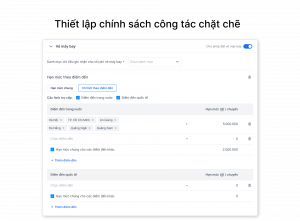
4.2 Automate the expense creation and approval process
Bizzi Expense helps businesses set up and adjust flexible spending policies for each department and project, helping to tightly control budgets and limit financial risks.
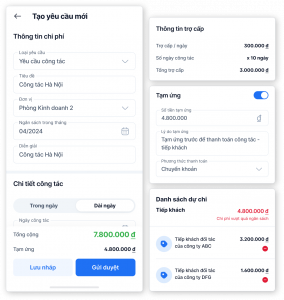
4.3 Budgeting and real-time cost tracking
Bizzi Expense supports detailed budgeting for each department and project, allowing real-time tracking of spending. As a result, businesses can better control financial resources and make quick decisions.
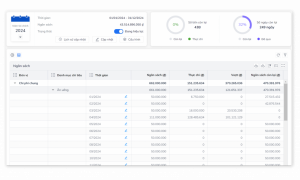
4.4 Warning of irregular and over-budget spending
The system automatically detects and warns of unusual or over-budget spending, helping businesses avoid waste and control costs effectively.
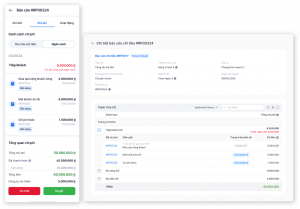
4.5 Visual reporting and cost analysis
Provides visual reports on costs and budgets, helping managers gain a comprehensive view and make decisions based on accurate data
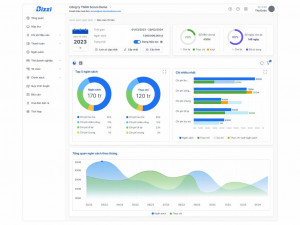
4.6 Integration of ERP and other financial systems
Bizzi Expense integrates flexibly with existing ERP systems and financial software, creating data synchronization and enhancing financial management efficiency.

Businesses can sign up for a trial of Bizzi Expense at:https://bizzi.vn/dang-ky-dung-thu/
Conclude
Optimizing costs in a business is a continuous process and requires determination from both leaders and employees. To achieve efficiency, businesses need to choose solutions that are suitable for their actual situation. Applying comprehensive business management solutions, such as ERP systems, can help automate processes, reduce waste and improve efficiency. In addition, contacting management consultants will provide in-depth perspectives and support businesses in implementing effective cost optimization strategies.


